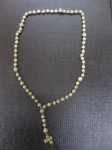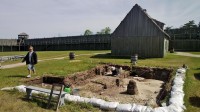 Archaeologists excavating the fur trading village and colonial fort of Michilimackinac on the tip of Michigan’s lower peninsula have discovered a rare intact rosary that may be as much as 250 years old. Colonial Michilimackinac is an open air museum and state park on the site of an 18th-century French fort and fur trading village just west of Mackinac Bridge on the shores of Lake Michigan. It has been excavated every summer since 1959, one of the longest continuous excavations in the country, and more than one million artifacts have been unearthed. The most common finds are fish bones and small objects like beads, buttons and broken glass. Finding an intact artifact of any kind is very rare — the last one was a pocketknife about four years ago — and finding a delicate rosary still intact is exponentially rarer.
Archaeologists excavating the fur trading village and colonial fort of Michilimackinac on the tip of Michigan’s lower peninsula have discovered a rare intact rosary that may be as much as 250 years old. Colonial Michilimackinac is an open air museum and state park on the site of an 18th-century French fort and fur trading village just west of Mackinac Bridge on the shores of Lake Michigan. It has been excavated every summer since 1959, one of the longest continuous excavations in the country, and more than one million artifacts have been unearthed. The most common finds are fish bones and small objects like beads, buttons and broken glass. Finding an intact artifact of any kind is very rare — the last one was a pocketknife about four years ago — and finding a delicate rosary still intact is exponentially rarer.
State parks archaeologist James Dunnigan found the rosary, made of ivory beads with brass links, while excavating at the home of French-Canadian fur trader Charles Gonneville, who worked the area between the 1730s and 1750s.
The assumption is that the rosary belonged to Gonneville or a family member.
It makes sense that a rosary would fall through the cracks in the floorboards of Gonneville’s house since he and his family were Roman Catholic. The English who occupied in the fort after 1761 when it was ceded to the British along with the rest of France’s Canadian holdings after its loss in the French and Indian War would have been predominantly Anglican. Still, it was a hard-won find. The Gonneville house has been excavated for the past eight seasons.
The fort was built in 1715 on the Straits of Mackinac, part of a vast network of supply depots and trading posts established by the French from the St. Lawrence to the Mississippi. The British only occupied it for 20 years, abandoning it in 1781 for greener pastures in the form of the limestone fort on Mackinac Island. They were concerned that a wooden fort on the mainland was too vulnerable to attack by the rebellious American colonies, so from 1779 to 1781 the British moved everything that could be moved from Fort Michilimackinac to Fort Mackinac, including wooden buildings which were taken apart and rebuilt on the island. The rest was burned and soon buried by the wind-blown sands of the shore.
 The site managed to survive without being developed or built over. When Mackinaw City was constructed in the mid-19th century, the fort site was made a park. The town gave the park to the State of Michigan in 1904 and the Mackinac Island State Park Commission claimed it in 1909 for Michigan’s second state park. A popular campground in the 1920s, the fort site saw its first attempts at reconstruction in 1933 when the palisade was rebuilt. In 1959, a year before it was designated a National Historic Landmark, the fort site saw its first professional excavation. The archaeological exploration made more accurate reconstructions of fort structures. Reconstruction began in earnest in 1960. The 1933 palisade was demolished and a more historically accurate one constructed.
The site managed to survive without being developed or built over. When Mackinaw City was constructed in the mid-19th century, the fort site was made a park. The town gave the park to the State of Michigan in 1904 and the Mackinac Island State Park Commission claimed it in 1909 for Michigan’s second state park. A popular campground in the 1920s, the fort site saw its first attempts at reconstruction in 1933 when the palisade was rebuilt. In 1959, a year before it was designated a National Historic Landmark, the fort site saw its first professional excavation. The archaeological exploration made more accurate reconstructions of fort structures. Reconstruction began in earnest in 1960. The 1933 palisade was demolished and a more historically accurate one constructed.
Just as archaeology is an ongoing process in Colonial Michilimackinac, so is site reconstruction. The aim is to rebuild the fort as it looked in the 1770s. Guides, known as interpreters (of history), dress as British soldiers in the classic red coats, Native American residents, French traders, family members, anyone who would have had reason to be at the fort in colonial times. Visitors to the park can get a glimpse of colonial life through the reconstructions and reenactments like the ever-popular cannon fire demonstrations, and see archaeologists at work during the dig season from early June to mid-August.
The rosary is being conserved now. Curators expect that it will be ready for display at the fort’s permanent Treasures of the Sand exhibit this fall.